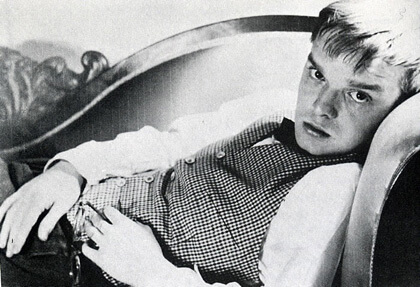Vito Vincent and Emilia Clarke in Richard Greenberg’s adaptation of the Truman Capote novella “Breakfast at Tiffany’s.” | NATHAN JOHNSON
Back in 1966, producer David Merrick famously pulled the plug on a Broadway musical version of “Breakfast at Tiffany’s” after just four previews. Not even the stellar team of Mary Tyler Moore, Richard Chamberlain, Sally Kellerman, Edward Albee (book), and Bob Merrill (score) could make it gel.
Evidently, Merrick did not wish to “subject the drama critics and the public to an excruciatingly boring evening.”
Now, for the first time in nearly half a century, “Breakfast at Tiffany’s” is back on Broadway, this time in a nonmusical adaptation by Richard Greenberg (“Take Me Out” and the book for the upcoming musical “Far From Heaven”). And while I won’t go so far as to declare the bittersweet drama an excruciating bore, it does lack the charming insouciance of the beloved Audrey Hepburn movie and the gritty sophistication of the indelible Truman Capote novella.
This slight adaptation of Truman Capote classic will leave you hungry
Greenberg chose to hew more closely to the novella, set in New York’s Upper East Side against the grim wartime backdrop of the 1940s, rather than the go-go early ‘60s of the film. He’s lifted generous chunks of Capote’s sharp dialogue, one of the few strengths of this sketchy production.
By design, the main characters are restless and callow, desperately searching for sense of self and a toehold on happiness. The pretty young Holly Golightly has reinvented herself after literally running away from a dull life in the sticks (her real name is Lulamae Barnes). Until she finds Mr. Right, or at least Mr. Moneybags, she’s counting on the kindness of gentlemen callers with “old money and sour breath” to pay her way. She’s more “American geisha” than prostitute, as Capote once noted.
Living in a shabby apartment upstairs is Fred, a gangly, aspiring writer unsure of who he is or what he wants. This “nice young man” appears to fall in love with Holly — or at least with her glamorous, party-filled joie de vivre. And her secret vulnerability, which he shares. At awkward moments, he addresses the audience directly, serving as narrator.
While the 1961 film scrubbed the story of any hint of Fred’s homosexuality, Greenberg deliberately offers up hints that he is gay, even adding a scene where he is dismissed from his menial job at the New Yorker for frolicking with a male colleague in the supply room (“I had a need; he supplied it,” quips Fred, in one of his finest moments.) Capote admitted that Fred was partly modeled on himself and that the curious bachelor was indeed gay.
Under the shaky direction of Sean Mathias, these characters are not simply quirky — they register as phantoms. Their relentless stream of impulses and contradictions make them difficult to get a handle on or connect with.
If Emilia Clarke (HBO’s “Game of Thrones”) looks the part of the plucky ingénue (the chic dresses by Colleen Atwood certainly help), her portrayal is too mannered to be entirely convincing. It’s not easy gushing buoyant bon mots one minute and battling the depressive “mean reds” the next, and she doesn’t always get it quite right.
Likewise, Cory Michael Smith, who delivered strong turns in the small plays “Cock” and “The Whale,” seems out of his depths on a Broadway stage, lacking the chops to thoroughly evoke Fred’s conflicted mental state. His southern drawl seems to come and go as capriciously as Holly’s whims.
It’s no surprise that this enterprise marks their first outing on the Great White Way.
The mismatched couple is surrounded by a swirl of socialites, neighbors, paramours, and phony friends. George Wendt makes an appearance as the kindly bartender with a crush on the wacky Holly, but even the former “Cheers” regular looks uneasy at the bar.
Not that the collaborators didn’t try to inject some oomph into the proceedings. They’ve introduced a live orange tabby, simply referred to as “Cat” (he’s credited as Vito Vincent and is backed by two alternate cats), who in his first scene appeared to exit before his cue. Later, his hasty retreat — appropriate this time, as Holly has just set him free to find his own destiny — got plenty of applause.
In the first act, the sultry ingénue sings a mournful ballad about a lost traveler — a far cry from “Moon River” but engaging nonetheless. They’ve also added a clumsy bathtub scene, where both actors strip naked, that’s as distracting as it is bewildering.
Derek McLane has devised an attractive set of New York brownstone interiors and a wrought iron fire escape, enlivened by moving scrims with projected images of moody black-and-white cityscapes.
Just like the unformed and aching Holly and Fred, this sincere yet tentative “Breakfast at Tiffany’s” is searching to find solid footing.
BREAKFAST AT TIFFANY’S | Cort Theatre | 138 W. 48th St. | Tue.-Thu. at 7 p.m.; Fri.-Sat. at 8 p.m.; Wed., Sat. at 2 p.m.; Sun. at 3 p.m. | $37-$132 at telecharge.com or 212-239-6200



































